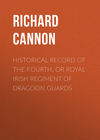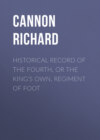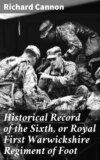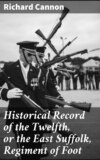Loe raamatut: «Historical Record of the First Regiment of Foot», lehekülg 15
"Approved.
"WILLIAM R."18th October 1832."
1st Batt
In the meantime the service companies of the 1st battalion had removed from the island of Trinidad, – three companies and head-quarters to St. Lucia, and three companies to Dominica. On their departure from Trinidad, the following order was issued by the Governor of the island: —
"Trinidad, 16th January, 1832.
"AFTER BRIGADE ORDERS
"His Excellency Major-General Sir Lewis Grant cannot allow the head-quarters of the Royal Regiment to quit Trinidad without expressing to Lieut. – Colonel Carter, and the officers, non-commissioned officers, and men of the regiment, the very great satisfaction their general conduct, both as officers and men, has afforded him since his landing at Trinidad.
"The decorous conduct of the corps, and the perfect manner in which its duties have been performed, entitle it to the greatest praise. For this His Excellency returns to Lieut. – Colonel Carter his particular thanks, and requests he will make a communication to the same effect to the officers and others under his command.
"His Excellency assures the officers and men of the Royal Regiment that they carry with them his best wishes for their welfare."
1833
On the 26th of October, 1833, the reserve companies of the 1st battalion embarked from Glasgow for Ireland, and landed at Londonderry on the 28th of that month.
2nd Batt
In December of the same year the second battalion embarked from Glasgow, and, having landed at Belfast, was stationed in Ireland two years and a half.
1834
His Grace the Duke of Gordon was removed in December, 1834, to the Third, or Scots Fusilier Regiment of Foot Guards; and the Colonelcy of the Royal Regiment was conferred by His Majesty King William IV., on General Thomas Lord Lynedoch, G.C.B., from the 14th Regiment of Foot.
1835
1st Batt
The six service companies of the 1st battalion quitted the West Indies in December, 1835, and proceeded to Ireland, where they arrived in the early part of 1836; and, having joined the reserve companies, the battalion remained in that part of the United Kingdom upwards of two years.
1836
2nd Batt
During the summer of 1836, the 2nd battalion was divided into six service and four depôt companies; and in July the service companies embarked at Cork for Canada, leaving the depôt companies at Boyle, from whence they were removed in the succeeding year to Newbridge.
The service companies landed at Quebec on the 24th of August, and passed the winter and succeeding spring in garrison at that city.
1837
In May, 1837, two serjeants and twenty rank and file were detached from Quebec to Grosse Isle, where they were stationed, with a detachment of the Royal Artillery, and of the 15th and 66th regiments, under Major Jackson. The remainder of the service companies proceeded in July from Quebec to Montreal, where they were stationed, with the 32nd and a small detachment of the 15th, under the orders of Lieut. – Colonel Wetherall, K.H., of the Royals. A detachment of nine rank and file of the Royals was stationed at Sorel; and in August the party was withdrawn from Grosse Isle.
2nd Batt
On the 24th of September the depôt companies of this battalion embarked at Kingstown for England, and landed on the 26th at Devonport.
Previous to the arrival of the Royals in Lower Canada, the minds of the inhabitants of that flourishing colony were agitated by factious men, who sought to dictate to the Government measures not deemed conducive to the welfare of the state. During the summer, the House of Assembly refused to proceed in its deliberations until the demand for the total alteration of the legislative powers was complied with; and this was followed by the appearance of many of the colonists in arms, and by open violations of the law. The revolt rapidly extending, the law-officers of the Crown and the magistrates of Montreal applied to Lieut. – General Sir John Colborne, K.C.B. (now Lord Seaton), the commander of the forces in Canada, for a military force to assist in apprehending several persons charged with high treason, who were supposed to be at the villages of St. Denis and St. Charles; and Colonel Gore was sent with detachments of the 24th, 32nd, and 66th regiments, and one howitzer, with a magistrate to St. Denis; at the same time Lieut. – Colonel Wetherall, K.H., of the Royals, was directed to move with Captain David's troop of Montreal cavalry, four companies of the Royals, a detachment of the 66th, and two six-pounders, from Chambly, on St. Charles, a village seventeen miles from the ferry at Chambly, to assist the magistrates in executing the warrants.
The detachment under Lieut. – Colonel Wetherall passed the river Richelieu by the upper ferry at Chambly; but the severity of the weather, and the bad state of the roads, impeded the march, and information having been received of the increased numbers of the rebels at St. Charles, the detachment halted at St. Hilaire until joined by another company of the Royals from Chambly. On the 26th of November the detachment resumed its march, and on arriving within a mile of St. Charles it was fired upon by the insurgents on the opposite side of the river, and one man of the Royal Regiment was wounded. Several rifle shots were also fired from a barn in front, which was burnt by the detachment. On arriving at the vicinity of St. Charles 1500 rebels were found posted in a close stockaded work, which was attacked; and after firing a few rounds, the troops assaulted and carried the defences by storm, killed a number of the rebels, took sixteen prisoners, and burnt the buildings. The Royals had 1 Serjeant and 1 rank and file killed; 8 rank and file severely, and 7 slightly, wounded. Lieut. – Colonel Wetherall's horse was shot under him during the action, and Major Warde's horse was severely wounded, and died afterwards. The detachment of the 66th had 1 man killed and 3 wounded.
Lieut. – Colonel Wetherall observed in his despatch: – "Every officer and man behaved nobly. Major Warde carried the right of the position in good style, and Captain Glasgow's artillery did good execution. He is a most zealous officer. Captain David's troop of Montreal cavalry rendered essential service during the charge."
After this success the detachment retired, on the 27th of November, to St. Hilaire, and advanced on the following day towards Point Olivière, to attack a body of rebels who had taken post at that place, and constructed an abatis, for the purpose of cutting off the retreat of the detachment; but when the troops formed for the attack, the rebels, after exchanging a few shots, fled, leaving two guns mounted on carts behind them. The detachment returned on the same day with 25 prisoners to Chambly, the men having suffered much from heavy rains, roads knee-deep in mud, and also from frost and snow.
In the meantime the detachments under Colonel Gore had, from obstructions of a formidable nature, and from the severe state of the weather, failed in the attempt on St. Denis, and had retired. The conduct of Lieutenant Lysons of the Royal Regiment, attached to the Quarter-Master General's department, who was employed on this service, was spoken of in terms of commendation, and also the exertions of Surgeon Farnden, in rendering assistance to the wounded. After the success of the Royals at St. Charles, the rebels broke up from their post at St. Denis.
The rebellion was, however, not arrested in its progress, and the troops had much harassing duty to perform in severe weather. On the 13th of December Lieut. – General Sir John Colborne proceeded with all his disposable force (including the companies of the Royal Regiment) towards St. Eustache, to put down the revolt in the country of the Lake of the Two Mountains, where the insurgents had driven the loyal inhabitants from their homes, and had pillaged an extensive tract of country. The Royals, with the Montreal rifles, and Captain Globinsky's company of volunteers, formed a brigade under Lieut. – Colonel Wetherall. The volunteers were detached to the woods bordering on the upper road to St. Eustache, to drive in and disperse the rebel piquets. The remainder of the brigade, with the other disposable troops, crossed the north branch of the Ottawa river on the ice, on the 14th of December, advanced upon St. Eustache, and entered the village at several points. The Royals and Montreal rifles advanced up the main street, and took possession of the most defensible houses. An officer was detached to bring up the artillery; but he was driven back by the fire of the rebels, who had taken post in the church. The artillery entered the village by the rear, and opened their fire on the church door, while some companies of the Royals and rifles occupied the houses nearest to the church. After about an hour's firing, and the church doors remaining unforced, a party of the Royals assaulted the presbytery, killed some of its defenders, and set it on fire. The smoke soon enveloped the church, and the remainder of the battalion advanced; a straggling fire opened upon them from the Seignior's house, forming one face of the square in which the church stood, and Lieut. – Colonel Wetherall directed the grenadiers to carry it, which they did, killing several, taking many prisoners, and setting it on fire. At the same time part of the battalion commanded by Major Warde entered the church by the rear, drove out and slew the garrison, and set the church on fire. 118 prisoners were made in these assaults. The Royals had 1 man killed and 4 wounded in this service.
On the 16th the Royals advanced with the remainder of the disposable force to St. Benoit, where no opposition was offered; and the rebels sent delegates to say they were prepared to lay down their arms unconditionally. The Royals returned to Montreal, where they arrived on the 17th of December with the prisoners. The good results of these movements were the return of the peasantry to their usual occupations, and the disappearance of armed parties of the rebels.
1838
1st Batt
In May, 1838, the first battalion proceeded from Ireland to Scotland.
1839
1st Batt
In November, 1839, the first battalion was again directed to prepare for foreign service, and the six service companies were embarked from Greenock for Gibraltar on the 11th and 25th of that month, on board the troop ships Athol and Sapphire.
1841
The four depôt companies remained in Scotland until May, 1841, when they were embarked for Ireland.
1843
2nd Batt
In September, 1843, three companies of the second battalion were embarked at Toronto for the West Indies; and on the 28th October the head-quarters, with the other three companies, under the command of Major Bennett, were embarked at Quebec for the same destination on board of the Premier transport, which was wrecked in the Gulf of St. Lawrence, but fortunately no lives were lost, and the three companies returned to Quebec on the 12th November.
On the 18th December, 1843, General Lord Lynedoch died, and the colonelcy of the regiment was conferred by Her Majesty on General the Right Honourable Sir George Murray, G.C.B., from the 42nd Royal Highland Regiment.
1844
The head-quarters and the three companies of the second battalion, under the command of Lieut. – Colonel Bell, again embarked from Quebec on the 20th May 1844, and arrived on the 1st June at Halifax, Nova Scotia, where they remained until November, when they proceeded from Halifax to the West Indies, and arrived at Barbadoes on the 8th and 17th November.
1846
The service companies of the second battalion returned from the West Indies in January, 1846, and arrived at Leith on the 21st March, from whence they proceeded to Glasgow, where they were joined by the depôt companies, which embarked from Belfast in May, 1845.
1st Batt
The service companies of the first battalion embarked from Gibraltar for the West Indies, on the 17th February, 1846, and arrived at Barbadoes on the 21st March. The depôt companies, which proceeded from Glasgow to Dublin in 1841, remained in Ireland.
On the 28th July, 1846, General the Right Honourable Sir George Murray, G.C.B. died, and Her Majesty was pleased to confer the colonelcy of the First or Royal Regiment of Foot on General the Right Honourable Sir James Kempt, G.C.B., from the Second, or Queen's Royal Regiment of Foot.
The head-quarters of the first battalion are at Trinidad: the depôt companies at Newbridge: the second battalion is at Edinburgh, at the close of the year 1846, at which period this record is concluded.
1846
The foregoing account proves the antiquity of the First, or Royal Regiment of Foot, and gives a statement of its services for a period of more than 200 years, during which it has acquired laurels under the great Gustavus Adolphus, king of Sweden, and under the French Marshals, Turenne, the Prince of Condé, Luxembourg, and De Crequi: it has since formed a part of the British army which has fought and conquered under King William III., Marlborough, Abercromby, Moore, and Wellington, the most celebrated warriors and consummate generals of their periods; thus establishing a fame and distinction which, it is presumed, few, if any, other military bodies in Europe can claim. The career of the Royal Regiment has not evinced a feverish and uncertain valour, sometimes emitting sudden flashes which startle and surprise, and at others betraying weakness and pusillanimity, but it has proved uniform and invincible; and whether employed against the barbarous tribes of Asia, Africa, and America, or the disciplined legions of Europe, the officers and men of the Royal Regiment have, on all occasions, displayed the native energy, firmness, and contempt of danger peculiar to Britons; and by their victories in every quarter of the globe, they have established a reputation for future ages to emulate.
Posterity, looking back at the splendid achievements of the British arms in various parts of the world, will naturally inquire what regiments won honour and fame in the several fields of glory where British valour was sternly proved. To this it may be answered that, in the seventeenth century, when Gustavus Adolphus stood forth the champion of the Protestant princes of Germany, this regiment fought and conquered in that glorious cause; and it claims the honour of having fought at the battle of Leipsic, famous in the history of Sweden, and at Roucroy, celebrated in the annals of France.
In the succeeding century, when the balance of power in Europe was destroyed by the union of France and Spain, and Louis XIV. sought to dictate laws to Christendom, this regiment was one of the first which appeared at the scene of conflict, and it shared in the victories of Blenheim, Ramilies, Oudenarde, and Malplaquet, also in the honour of capturing the fortresses which that ambitious monarch had erected as bulwarks to his kingdom; and thus purchased peace for Europe.
When Bonaparte, whose hatred and jealousy of England were unalterable, sought to become more than the dictator of Europe, this regiment met the legions of the usurper, and fought and triumphed in battles, which are inscribed on its colours as monuments to stimulate to deeds of valour the men of future generations, who shall enrol themselves under the banners of the Royal Regiment. Besides these leading features of its career, in which the national character and influence have been elevated, this regiment has evinced equally brilliant qualities in actions which, though less important in their bearing on the affairs of Europe, have attested the intrinsic merit of the corps, and have purchased numerous advantages to the commerce, power, stability, and happiness of Britain.
SUCCESSION OF COLONELS OF THE FIRST, OR ROYAL REGIMENT OF FOOT
Sir John Hepburn, Appointed 26th January, 1633
John Hepburn139 descended from the Hepburns of Bothwell, an ancient and distinguished family, which for many ages had extensive possessions in East Lothian. His father was proprietor of the lands of Althestaneford, and gave young Hepburn a liberal education. From his earliest youth he was remarkable for spirit and resolution. When he quitted college he made the tour of part of Europe (in 1615), and the rising fame of Gustavus Adolphus of Sweden, of whose character he heard frequent commendations, gave birth to a spark of military ardour within his breast which was never extinguished till his death. Soon after his return from his travels, when the attempt was made to rescue Bohemia from the power of Austria, he engaged in the cause of liberty, and commanded a company of foot at several sieges and actions in Bohemia, Alsace, and Germany, and at the battle near Fleurus. When the King of Bohemia's forces were disbanded, he entered the service of the Swedish monarch. In his first essay in arms he displayed an ardour which procured him the favour and approbation of Gustavus, whose vigilant eye soon detected in this aspiring youth all the qualities requisite to constitute an excellent soldier. After a short service in the subordinate commissions he was quickly advanced to the command of a regiment, and was employed in services which required a considerable portion of skill and valour. He was invariably either at the head of his regiment, or at the head of the brigade of which his regiment formed part, and, as his regiment was incorporated into a Scots corps in the French service, now the First, or Royal Regiment of Foot, his services are set forth in the historical record of this corps, where his name will be found associated with deeds of valour and heroism of particular brilliancy. He appears to have been celebrated equally for bravery, skill, and humanity: he was beloved and esteemed by Gustavus Adolphus, and also by his companions in arms, both officers and soldiers; and his presence inspired confidence in the ranks of the brave Scots who fought under his command.140
That innate spirit and fire which constituted a part of his character, rendered him incapable of brooking even an imaginary injury; and Gustavus Adolphus, who was equally remarkable for the fiery temperament of his constitution, having uttered one or two sharp expressions to the brave Scottish warrior, he declared he would never more unsheath his sword in the Swedish quarrel. The king is said to have placed more confidence in this officer than in any other colonel in the Swedish army; and some days before their disagreement his Majesty had appointed him to the command of half the infantry in the camp at Nuremberg. The king afterwards made several condescensions to Hepburn, and appeared particularly desirous of retaining this valuable officer in his service; but the Scottish hero was inflexible, and he quitted the Swedish army in 1632. On his arrival at the British court, his fame having preceded him, he was knighted. He soon afterwards tendered his services to the king of France, who was too well acquainted with the character, capabilities, and experience of this renowned Scot, not to give him employment, and he was placed at the head of a regiment, constituted of some new levies and old Scots companies in the French service, now the First, or Royal Regiment of Foot, in the British line. His commission was dated the 26th of January, 1633; and at the head of this corps he distinguished himself in Alsace and Germany, and had the satisfaction of seeing many of the veterans of his former regiment incorporated in his new corps. He commanded a division of the French army on the Rhine, and was on the point of being advanced to the dignity of a Marshal of France; but he was killed at the siege of Saverne, before the diploma reached him. Thus terminated the career of one of the best officers Scotland ever produced. He was known in France by the title of the Chevalier Hebron; and such was the fame of his gallantry, that, although he was killed in the reign of Louis XIII., a monument was erected to his memory some years afterwards by Louis XIV., in the cathedral of Toul. A contemporary historian (Lithgow) states "he was one of the best soldiers in Christendom, and, consequently, in the world."



















